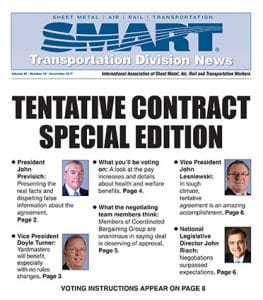
“The proposed revisions would modernize locomotive engineer certification regulations to match those for train conductors, and provide regulatory efficiencies and cost savings without compromising safety,” FRA Administrator Ronald L. Batory said. “The proposal would streamline the engineer certification process, and reduce paperwork burdens for the responsible parties.”
The proposed rule would adopt the conductor certification regulation process established in 2012 by making conforming amendments to the engineer certification regulation, which was first issued in 1991 and last amended in 2000. Consistent with Executive Order 13771, the proposed rule would reduce overall regulatory reporting and cost burdens for railroads and locomotive engineers. Harmonization of the conductor and engineer regulations would also provide greater clarity to locomotive engineers.
The NPRM includes the following five proposed changes to Title 49 of the Code of Federal Regulations, Part 240:
- Clarifies locomotive engineer certification requirements (Part 240) and aligns them with conductor certification requirements (Part 242) to make it easier for railroad certification managers to become familiar with and administer both regulations.
- Reduces the reporting burden of a person’s former employer to clarify that only certain listed information in the individual’s railroad service record that directly relates to FRA’s requirements in the certification regulation needs to be shared.
- Defers the requirement for railroads to seek a waiver from annual testing of certified locomotive engineers when individuals take an extended absence from performing service requiring certification.
- Modernizes the dispute resolution process by reducing the paperwork burdens for both employees and railroads and allowing for web-based dockets.
- Simplifies the submission process by which qualification and certification programs are modified by allowing electronic submissions.
The proposed revisions for locomotive engineer qualification and certification ensure that certain provisions are consistent, to the extent possible, with those for conductors. FRA is seeking comments on the proposed rule, and will address comments received when preparing a final rule. Comments may be submitted to the docket for the proceeding FRA-2018-0053, and are due by July 8, 2019. Read the full proposed rule here.

 On July 7, Grupo Mexico S.A.B. de C.V. announced that its Grupo Mexico Transportes S.A. de C.V. unit (GMXT) completed its procurement of Florida East Coast Holdings Corp., parent company of Florida East Coast Railway (FECR).
On July 7, Grupo Mexico S.A.B. de C.V. announced that its Grupo Mexico Transportes S.A. de C.V. unit (GMXT) completed its procurement of Florida East Coast Holdings Corp., parent company of Florida East Coast Railway (FECR).